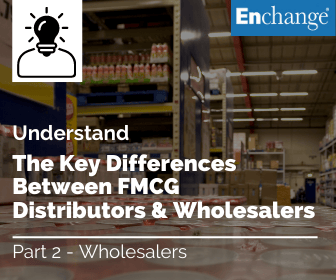This post is Part 2 of a series of posts discussing indirect distribution management, and specifically the characteristics and the key differences between FMCG Distributors and Wholesalers. You can read Part 1 which includes the Characteristics of Distributors here.
 The reason we are fleshing this out as a potential Route to Market (RtM) challenge, is that many FMCG Co.’s view or treat Distributors and Wholesalers the same way.
The reason we are fleshing this out as a potential Route to Market (RtM) challenge, is that many FMCG Co.’s view or treat Distributors and Wholesalers the same way.
There are of course many similarities between Distributors and Wholesalers, with both acting as intermediaries between the FMCG Co. and the retailer but identifying and understanding the differences is key to any RtM strategy.
We discussed the Characteristics of Distributors last time. In this article I will focus on the Characteristics of Wholesalers.
Wholesale Characteristics:
Agreements
- There may not be any agreement in place between the FMCG Co. and the wholesaler.
- Wholesalers, sometimes referred to as Cash & Carry’s or sub distributors or merchants or traders, etc., may buy their product from the distributor, not the FMCG Co.
- If the wholesaler has any RtM staff, it is unlikely the FMCG Co. will influence them.
Exclusivity
- Wholesalers are seldom exclusive and usually sell whatever products they choose.
- Wholesalers can be very focused on price, even if this means procuring brand or SKU formats not destined for their normal channel, market, or geography.
Management
- Wholesalers can be, and usually are, very important customers to the FMCG Co.
- They can play a key role in volume, trade coverage and sometimes access to certain markets or geographies.
- In some cases, Wholesale management may be assigned to Key Accounts, to Distribution managers or to the Field Sales team.
- Wholesalers tend not to be selected by the FMCG Co., they normally approach the FMCG Co. or their Distributor and look to become a customer.
- Wholesalers, as with distributors, require specific management effort to maximise their potential. This is not always appreciated by the FMCG Co.
- It is important to note that the top tier of today’s wholesalers, could be tomorrows distributors.
Territories
- Wholesalers are seldom assigned a specific geography, territory, region, or country.
- Wholesalers tend to sell their products to whomever wants to buy them, in some cases using eCommerce platforms and perhaps cannibalising volume from other channels or territories.
- In recent years some modern trade retailers have used their buying power and eCommerce platforms to offer Wholesale services.
Brand Range & SKU’s
- The Wholesaler usually stocks whatever brands and SKUs will sell the fastest, and deliver the strongest margin, regardless of any FMCG Co. RtM strategy.
Remuneration
- Wholesalers tend to be renumerated by margin, front margin (% mark-up) and/or back end margin (volume discount or rebate).
- Margins tend to be more top down, than specifically negotiated. For example, the Wholesale Channel usually determines their own % mark up, but could be offered a specific volume rebate from the FMCG Co.
- Wholesalers almost always take ownership of the product.
Operations
- Wholesalers are seldom in the logistics business; they usually have a premises that the retailer or customer can visit to purchase goods. In some cases, consumers can shop at Wholesalers.
- Wholesalers may offer delivery for some key retailers/customers.
- Wholesalers seldom get involved with customer visits, customer classifications, call frequency, or other trade marketing activities.
- Wholesalers are seldom reliant on a single FMCG Co., who are usually a small part of their overall turnover.
As we said when discussing the Characteristics of Distributors in my last article, the above are not hard and fast rules, but they do provide guidance. In my next article I will discuss some key areas to focus on, in relation to Distributors and Wholesalers for an effective Route to Market Strategy that gets the best from both. Here is a link to Part 3 in the blog series, 10 Key Focus Areas for Effective FMCG Distributor & Wholesale Management.
If you need help, please reach out to me directly. Feel free to use our 20 Steps to Route to Market Excellence model to give you inspiration on your RtM journey.







